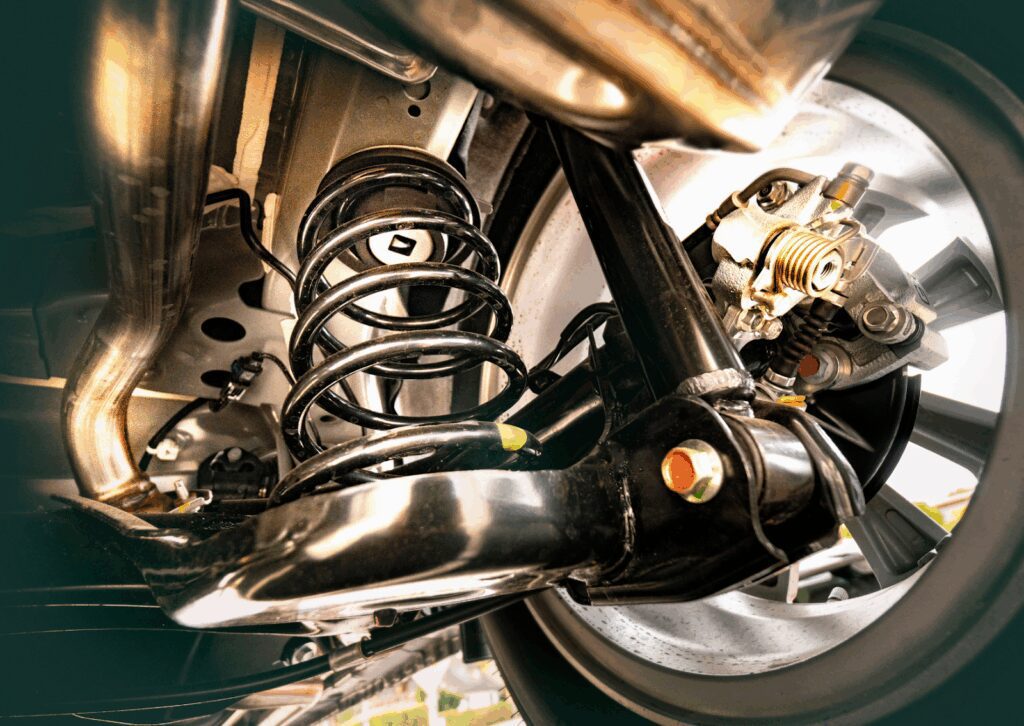We often take our vehicles for granted until something feels off. That slight pull to one side, the unsettling bounce over a speed bump, or a squeak when turning can all point to deeper issues. At Metric Motors, we’ve helped countless drivers in Loveland recognize and repair these problems before they turn dangerous. Your steering and suspension components play a massive role in how your vehicle performs and, more importantly, how safe it is. So, how do you know if your system is working properly or putting you at risk?
What Are Steering and Suspension Components and Why Do They Matter?

Your vehicle’s steering and suspension systems are designed to do more than just keep the ride smooth. They control how your vehicle’s wheels move in response to the road surface, manage your car’s suspension system, and ensure your steering wheel responds accurately.
Key steering and suspension parts include the steering rack, control arms, ball joints, tie rods, coil springs, shock absorbers, struts, and suspension components like leaf springs and suspension parts. These all work together to provide directional stability, a comfortable ride, and responsive handling.
How Does Your Power Steering System Affect Safety and Control?

Modern vehicles rely on a power steering system that includes a power steering pump, rack and pinion, steering column, and steering linkage. These components reduce the effort needed to turn the steering wheel, giving you better control at both low and high speeds.
If your power steering system is leaking, whining, or unresponsive, it can severely affect your vehicle’s ability to steer safely, especially in emergencies.
Are Worn Shock Absorbers Making Your Car Unsafe?

Shock absorbers are designed to control the rebound of your springs and maintain contact between your tires and the road. When they wear out, you may notice excessive bouncing, nose-diving when braking, or a rough ride.
Failing shocks compromise safety and comfort by increasing road shock and reducing suspension performance, making it harder to maintain control over bumps and uneven surfaces.
Is Your Car Steering as Precisely as It Should?

Your car’s steering depends on a combination of steering knuckles, steering rack, and tie rods to function properly. When these parts are loose or damaged, the vehicle might drift, pull, or feel vague while turning.
Precision in steering is essential for everyday driving and especially important in emergency maneuvers. Pay attention to how your steering wheel responds, any delay or stiffness may indicate trouble.
Could a Faulty Suspension System Be the Hidden Cause of Poor Handling?

A faulty suspension system doesn’t just affect ride comfort, it can also cause poor handling that puts you and others at risk. When parts like control arms, ball joints, or coil springs wear down, they disrupt your car suspension, making it harder to turn, brake, and accelerate safely.
This can be especially dangerous in wet or icy conditions where optimal grip and ride quality are essential.
Why Is a Smooth Ride More Than Just a Comfort Issue?

A smooth ride might feel like a luxury, but it’s actually a safety factor. Consistent contact between the tires and the road surface ensures reliable handling.
A compromised suspension system increases horizontal loads on suspension components, which may lead to quicker wear and unpredictable vehicle behavior.
What Role Do Ball Joints and Control Arms Play in Stability?

Ball joints and control arms are pivot points connecting your suspension system to the vehicle’s wheels. They allow for up-and-down motion while maintaining directional control.
If these components wear out, you may hear clunking sounds, experience excessive vibration, or suffer uneven tire wear, all of which are signs you should visit an expert like Metric Motors.
Is Your Pitman Arm Causing Directional Instability?

The pitman arm is essential in steering systems using a recirculating ball setup. It connects the steering gearbox to the center link, translating steering wheel motion into lateral movement.
When a pitman arm wears out, you might notice sluggish or erratic steering response, especially at low speeds.
Are You Ignoring the Warning Signs of a Failing Car Suspension?

Warning signs of suspension issues include:
-
Unusual noises while driving over bumps
-
Sagging on one side
-
Difficulty maintaining control
-
Ride height imbalance
-
Uneven tire wear
Suspension wear tends to sneak up over time. It affects the main functions of your vehicle’s handling, especially when carrying added vehicle’s weight or driving over rough roads.
Why Do Most Cars Experience Suspension Wear Over Time?

Most cars undergo thousands of miles of stress on springs, shocks, struts, and arms. Combined with seasonal weather, potholes, and time, these factors degrade your suspension parts.
Regular inspections catch these problems early, before they become expensive or dangerous.
How Does Rack and Pinion Steering Work and Can It Fail?

The rack and pinion system directly converts steering wheel rotation into linear movement of the wheels. It’s a compact, efficient system found in many modern vehicles.
When the rack or pinion gears wear out, steering may feel loose, unresponsive, or make odd noises. Fluid leaks around the steering rack are also a common red flag.
Are You Risking Uneven Tire Wear by Skipping Wheel Alignment?

Skipping wheel alignment not only causes uneven tire wear but can also stress your steering and suspension components. Misaligned front wheels or rear wheels affect how your vehicle tracks, brakes, and corners.
Proper alignment ensures all suspension components are working together, minimizing strain and maximizing ride smoothness and fuel efficiency.
Is Poor Wheel Assembly Affecting Your Vehicle’s Handling?

The wheel assembly includes the steering knuckle, wheel hub, ball joints, and tie rods. These parts are crucial for maintaining the connection between the tires and the suspension system.
Worn or damaged parts can lead to steering problems, wobbles at high speeds, or dangerous failures under load.
Do You Know the Main Functions of Steering and Suspension Systems?

The main functions of your steering and suspension systems are to:
-
Provide stable handling
-
Minimize road shock
-
Maximize tire contact
-
Ensure driver control in all conditions
Understanding how your systems work helps you recognize warning signs and stay safer on the road.
Is Your Air Suspension System Helping or Hurting Your Ride?

Air suspension replaces traditional coil springs with airbags. While they offer a smoother, adjustable ride, they are more prone to leaks and suspension issues as they age.
If your vehicle sags or adjusts height erratically, it’s time for a checkup.
When Should You Have Your Steering and Suspension Inspected?

If your vehicle shows any of the signs we’ve talked about—poor handling, noises over bumps, uneven tire wear, or loose steering, it’s time for a professional inspection.
At Metric Motors, we offer expert diagnosis and trusted repairs for your steering and suspension components. Whether it’s replacing shock absorbers, tightening a steering linkage, or aligning your rear wheels, our ASE-certified team is ready to help.
Call us today to schedule your inspection and get back to a safer, smoother ride.
Final Thoughts
At Metric Motors, we understand how critical your steering and suspension systems are to your safety and driving comfort. We’ve seen how a small issue with a power steering pump, rack and pinion, or control arms can lead to bigger problems. Our job is to make sure your vehicle stays reliable, safe, and easy to handle. Don’t ignore the signs, trust the team that’s been keeping Loveland drivers confident on the road.
Visit our shop or call to schedule a complete suspension and steering inspection today.
Frequently Asked Questions:
1. What are steering and suspension components in a car?
Steering and suspension components include parts like the steering rack, control arms, ball joints, coil springs, shock absorbers, tie rods, and struts. These work together to help your car steer accurately and absorb bumps for a smoother, safer ride.
2. How does the power steering system improve vehicle control?
The power steering system reduces the effort needed to turn the steering wheel. With components like the power steering pump and rack and pinion, it allows for precise and easier handling, especially at low speeds or during quick maneuvers.
3. What are the signs of worn-out shock absorbers?
Common signs include excessive bouncing, nose-diving when braking, uneven tire wear, or a rough ride. These symptoms indicate the shocks may no longer be absorbing road impact properly.
4. Can a bad suspension system cause poor handling?
Yes. A faulty suspension system affects your ability to control the car, especially when turning, braking, or driving on rough roads. Worn control arms, coil springs, or ball joints can all lead to poor handling and safety risks.
5. How do ball joints and control arms affect vehicle stability?
Ball joints and control arms allow your suspension to move while keeping the wheels properly aligned. If they fail, it can cause clunking noises, instability, and increased tire wear.
6. Why is wheel alignment important for safety and tire wear?
Improper wheel alignment causes uneven tire wear, pulling, and unstable steering. Keeping your front and rear wheels aligned ensures that suspension components work correctly and your car stays safe and efficient.
7. What does the pitman arm do in the steering system?
The pitman arm connects the steering box to the steering linkage and helps translate steering wheel movement into directional changes. A worn pitman arm can result in loose or unresponsive steering.
8. What causes uneven tire wear related to suspension issues?
Uneven tire wear is often caused by problems like misalignment, worn ball joints, or damaged suspension parts. These issues affect how your tires contact the road, leading to premature wear and poor ride quality.
9. When should I have my steering and suspension inspected?
You should get an inspection if you notice poor handling, strange noises over bumps, a bouncy ride, or uneven tire wear. Regular checks can prevent major repairs and keep your vehicle safe.
10. What are the main functions of the steering and suspension systems?
Their main functions include maintaining directional stability, absorbing road shock, ensuring even tire contact with the road surface, and allowing the driver to maintain control of the vehicle under all conditions.





